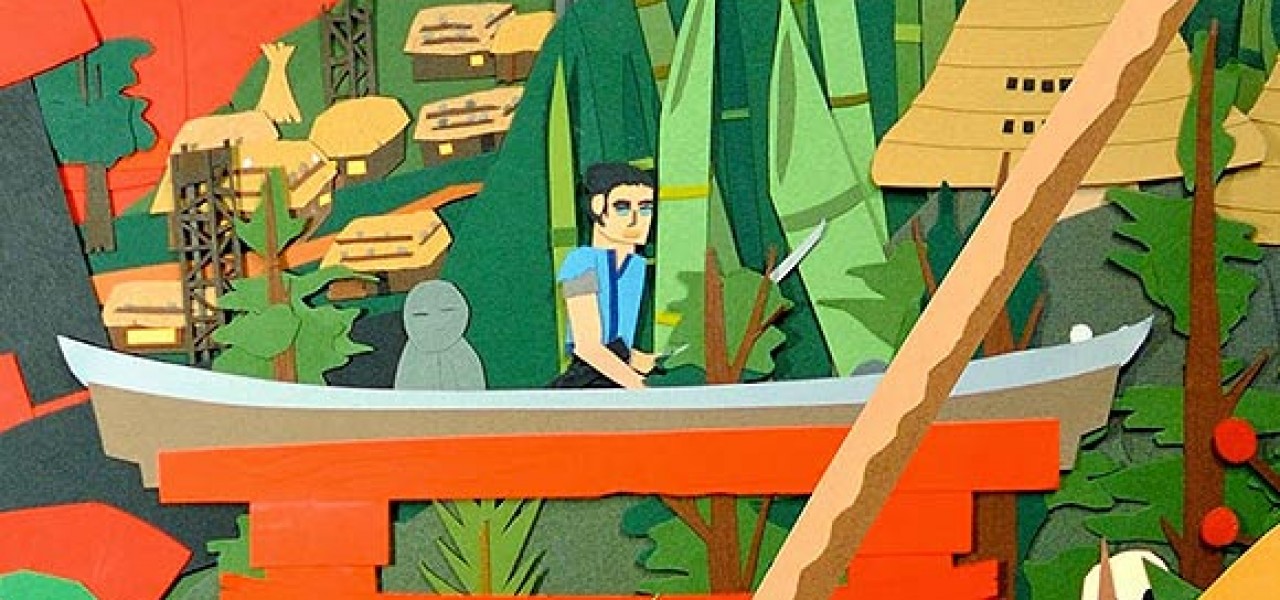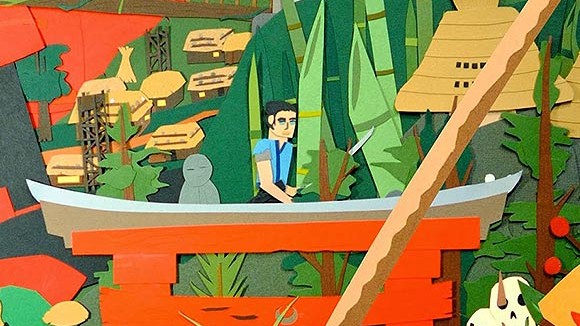

‘Path of Blood”s Eric Power on Making A Super Low Budget Cutout Samurai Feature

Can a cut-paper, stop-motion feature film capably and faithfully represent the tortured psychodrama and indulgent gore of samurai cinema? Or will it end up being, for lack of a better term, a poor cut-and-paste job?
For the most part, from its first bloody corpse to its body-ridden showdown, the mounting carnage of Eric Power’s Path of Blood—available on demand for stream or download exclusively through Vimeo—is genuinely shocking. Its sub-narrative, of banished samurai in search of restored glory at the end of a blade, still resonates even after its antihero spectacularly takes down the big baddie.

“I looked to the chanbara films of the ’60s and ’70s for inspiration,” the Austin, Texas-based Power told Cartoon Brew. “I was modeling my approach to the violence along the lines of those films like Lone Wolf and Cub and the Zatoichi series. “I wanted to steer away from a cartoon aesthetic and realize the cut-paper world the way a live-action film would be shot. My hopes were that people could get lost enough in the film to forget they were watching a cartoon. Adult animation is a hard sell, so instead of going too over the top, I decided to take it more seriously—as seriously as you can take a film with eviscerated paper ninjas, that is!”
Power became hooked on samurai cinema after watching Ran, Akira Kurosawa’s stunning remix of William Shakespeare’s King Lear, as a teenager. Later on, he began to gravitate toward cutout animation, a handmade tradition extending back to foundational 1920s classics like Noburo Ofuji’s Thieves of Baghdad and Lotte Reiniger’s The Adventures of Prince Achmed, reportedly the oldest surviving animated feature film.
“I paid homage to The Adventures of Prince Achmed in Path of Blood’s shadow animation segments,” said Power. “I intend on making a shadow animation feature in the future, but today I feel cut paper animation could definitely find a place in our culture. I’m happy to help contribute in my own way.”

Power said: “I first came across cut paper animation as a means to tell a story in a folk art style, but I eventually I fell more and more in love with working in the medium. One of the most exciting parts of the process is making all of the elements by hand. I’ve done quite a bit of digital animation over the years, but it is always refreshing to get tactile.”
Path of Blood’s tactility comes vividly across in the vicious hand-to-hand combat of Kazuo and the film’s masterless ronin, ninja assassins and more, who carve their way through a mysterious mountain path full of death and memory on their way to a legendary samurai stronghold. But Power’s skill as a cutout craftsman is even more evident in Path of Blood’s moments of stillness, where the viewer can appreciate the layered depth-of-field characteristic of the technique. Power infuses these moments with Many Birthdays’ postmodern western score, which evokes everything from Ennio Morricone’s greatest hits to Neil Young’s blistering guitar on Jim Jarmusch’s Dead Man.
“Many samurai films were inspired by Westerns,” Power said. “I love the multicultural sharing that went into them, and felt it would be fun to participate in the dialogue.”

The result is an ultraviolent samurai upstart light years away from the more winsome sweetness of “Tatooine,” Power’s geeky Star Wars video for Jeremy Messersmith’s song of the same name. And, although it gets close in its gorier moments, Path of Blood steers clear of the comic extremes of South Park, to which Power’s work is often simplistically compared. “It’s kind of like if people compared all hand-drawn animation to Snow White,” he said.
Power cut and animated Path of Blood by himself, using X-Acto blades, glue sticks, heavy glass, Dragonframe stop motion software and Final Cut Pro. Several months of production were dedicated to cutting out elements for the film. Power even watched all of the original episodes of the Twilight Zone to take inspiration from its distinctive foliage shapes and silhouettes.
Funding proved an even greater challenge than foliage. Path of Blood began life as a short in 2010, which toured the festival circuit, picking up heat along the way. That led to an ambitious Kickstarter project for a feature version, which folded after landing 40% of the $25,000 goal. Power admitted the funding goal was perhaps too high. But, once he cobbled together $20,000 by himself and from his own pool of contacts, Power got quickly to shooting, taking on freelance work to keep the lights on.

Support for his unconventional cutout experiment came from an unconventional corner: the video streaming and sharing service Vimeo, a site popular with indie filmmakers and DIY creatives. Owned by parent corporation IAC, Vimeo has lately moved beyond simply sharing shorts and features into funding and distributing work from Disney-owned Maker Studios, Warner Bros.-owned Machinima, and more exclusively on its Video On Demand platform—which is currently where Path of Blood makes its bloody bed.
“Vimeo has been a strong supporter of my work for years. I love their platform and passion for independent filmmaking,” Power said. “They followed my progress as I made it, and helped out so much with Path of Blood’s release. I also really love where on-demand distribution seems to be headed: It’s a year or two away from being more integrated with how people watch films. Right now, viewers still like the free model, or look to Netflix and other services. But I’m hoping that, as rental and buying become more widely digital, people will take more chances on alternative cinema.”
If the equitable digital distribution ecosystem that creatives truly deserve ever emerges, Power says, there’ll be a boom in independently animated features. “They won’t have the multimillion dollar polish, but they will have passion.”

